It’s hard to find a child who isn’t magically drawn to water. The water from the tap is just as exciting as the water in the bathtub. Outside, children happily jump through puddles after a rain shower, too. And let’s not forget ice cubes! Nevertheless, when it comes to aquatic fun, nothing beats a pool.
In this article, you’ll learn why children naturally feel right at home in this element, why it’s crucial to keep it that way, and why a slide is an absolute must.

The Amniotic Sac as a Miniature Pool
Water has been considered a symbol of life and renewal since ancient times. It radiates tranquility and stability, but also stands for movement, especially when you think of rivers. But beyond that – don’t we all come from water? In a word, yes. After all, what is amniotic fluid if not a quiet, protected space in which a fetus can develop in a completely relaxed manner? A miniature pool for the baby in the making. This is where it feels at home. And this feeling of well-being in water remains intact even after the birth.
The Innate Diving Reflex
Newborns who have only been alive for a few days have an innate diving reflex that can remain in place until they are six months old. Just as they learned in the womb, babies hold their breath as soon as they are under water. They stop breathing, the windpipe closes automatically to prevent water from entering, and their heartbeat slows down – a clever trick used by the body to reduce the need for oxygen. After nine months of developing in the amniotic fluid in the womb, the newborn’s senses are almost completely adapted to water – in fact, they even leave their eyes open in it.
But infants even hold their breath when only the skin of their face comes into contact with water – especially if it’s cold water. What comes naturally to them, older children have to relearn, however: that you can’t just keep breathing underwater, you have to hold your breath. That’s why it’s good if you reinforce what comes naturally – in the right way.
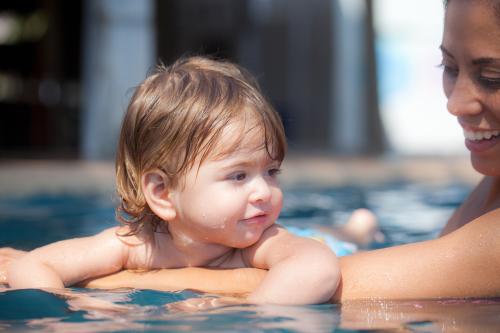
Initial Aquatic Experiences
Your own kiddie pool is the perfect place to do this, as your little one isn’t exposed to chlorine or the bacteria usually found in popular swimming lakes or in the ocean. Here you can also adjust the water temperature yourself so that both of you feel comfortable. You’ll be amazed at how fearlessly your tiny tot moves through the water – and how curious they are. You can slowly get your baby accustomed to water by pouring a little of it over his or her shoulders, then gradually over their head. Make them feel safe by talking to them gently as you do. The calmness of the water radiates onto you and your baby, bringing you closer together – the buoyancy also makes you both feel a lot lighter. Your child learns that they can trust you because you’re holding them securely. Many women develop a sense of what their child needs at a given moment and what they can already handle on their own. Go ahead and listen to your inner voice and your instincts without allowing yourself to be swayed too much by the advice of others. If you do, in the best case scenario, your child will never develop a fear of water in the first place, which, as you’ll see in a moment, is invaluable. When initially familiarizing your child with water, the focus shouldn't be on dunking them under – it’s a practice that’s the subject of much debate and contention among experts – but on the joy and fun of being in the water.
Improved Development
Once an infant is accustomed to water, they can gain numerous cognitive experiences during their first assisted aquatic exercises that will subsequently put them ahead of their peers who have no prior experience with water. This also supports the natural switch from thoracic breathing to deep abdominal breathing – from this point on, motor-controlled breathing replaces reflexive nasal breathing.
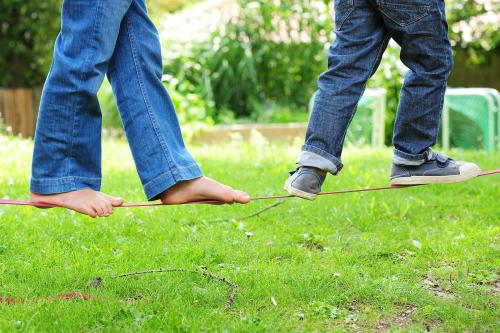
The journal Child: Care, Health and Development published a study in which two scientists, Hermundur Sigmundsson and Brian Hopkins, observed two-month to three-month-old babies. During swimming lessons, they splashed, dove, and did gymnastics together with their parents for four months, guided by an experienced swimming instructor. In tests conducted four years after the experiment, the researchers compared the abilities of these children with those who did not have any contact with water in their first few months of life. The results were astonishing – the children did particularly well in exercises involving their sense of balance. The situation was similar in tasks involving the ability to grasp objects. The “swimming babies” were able to coordinate their movements better and keep their balance more easily than their peers who had not been introduced to water earlier in life.
The experiment clearly showed the effect of playful training on young children’s later lives. They are physically superior to their peers and thus gain self-confidence.
The First 1000 Days
You may have heard about how important the first 1000 days are to your child’s development. In this context, the number doesn’t refer to the days after birth, but since the moment of conception. During this period, the baby’s body is particularly sensitive to external influences; this is where the foundation is laid for the child’s later development, health, and well-being. In fact, this initial period of time determines his or her future success in different areas of life. The body grows rapidly, the organs develop. The architecture of the brain takes shape, the connections between neurons form. A window of opportunity opens up in which the human body is still malleable and adaptable. If a child’s brain is stimulated in the right way at this early stage, for example through early encouragement in the form of initial aquatic games, it will have an influence on many other areas of life.
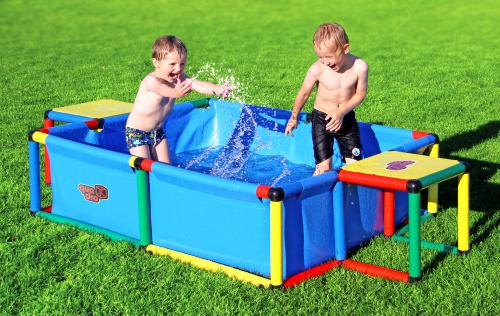
Water – Pure Pleasure
Whether in the bathtub at home, in your own kiddie pool, or later at the public pool – water spells pure pleasure for children. Almost all toddlers love this element, and are only too happy to splash and play in it. As soon as the weather permits, the equipment kids play with at parks first are always those that have to do with H2O. The cool water not only stimulates children’s imagination thanks to its versatility, it also awakens their spirit of discovery, their natural urge to try things out and experience something new. And the best way to do that is through play.
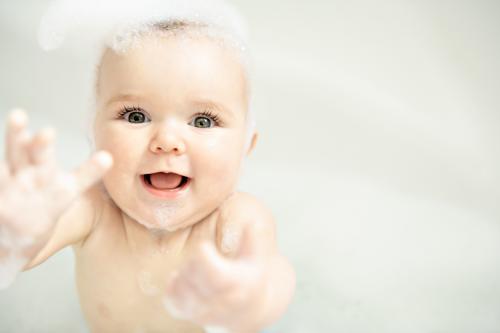
A pool in the backyard truly increases a family’s quality of life. They have a great time together here. But they won’t be alone for long – soon friends will come over who want to join in the fun. Thee children forge their first relationships and make new friends. For example, a children’s birthday party around the pool is a wonderful thing. Although you don’t always have to wait that long – why not throw a little pool party for no reason, just for fun?
In the safe environment that is their own backyard, the little ones get used to water in a playful way. They overcome their fear so that later in life, they’ll be brave enough to attempt their first strokes in a public swimming pool or other body of water under supervision. And this is how they’ll ultimately learn to swim. Considering that the number of children that die from drowning is on the rise, this is especially important. According to the German Life Saving Association (DLRG), a total 18 preschool and 5 elementary school children lost their lives in the water across Germany in 2020, and the number is increasing.
Swimming as an Important Skill
The DLRG reports that nearly 60 percent of 10-year-olds are not confident swimmers. They’re extremely unsure of themselves in the water and don’t know what they need to do in an emergency to save themselves. As a result, their risk of drowning is particularly high. The DLRG believes the problem lies in the fact that swimming isn’t offered everywhere at school – the number of schools that offer swimming lessons is decreasing from year to year. Water is often unfamiliar to children who haven’t learned to swim. They’re afraid to dunk their heads under and place their trust in this element. Yet learning to swim confidently has been proven to reduce the risk of drowning. And the earlier children are introduced to it, the easier it is for them to learn later. Starting at the age of about four, they have the motor control necessary to learn this skill.
But even apart from that, swimming has numerous benefits. It trains the entire musculoskeletal system, strengthens the muscles, and increases stamina and concentration. Because they need to move their arms and legs in sync, swimming has been shown to improve children’s coordination skills. They become more agile and stay slim. But the brain also develops through this mind-body connection – and with it, cognitive and emotional intelligence.
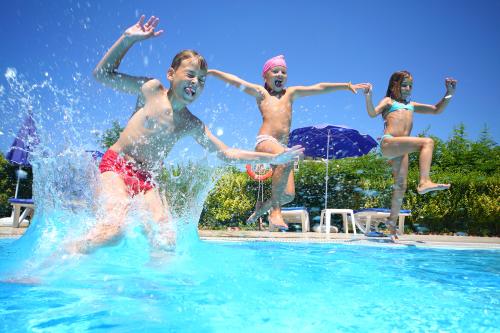
Once children get over their fear of swimming, they become more self-confident. They’re filled with optimism and become more even-tempered as they relieve stress. Here, too, they spend time among their peers and cultivate their first friendships. Last but not least, children who have learned to swim and dive benefit from greater freedom, because when on vacation with their families, they can discover the colorful underwater world in faraway countries or fearlessly take a plunge in the hotel pool.
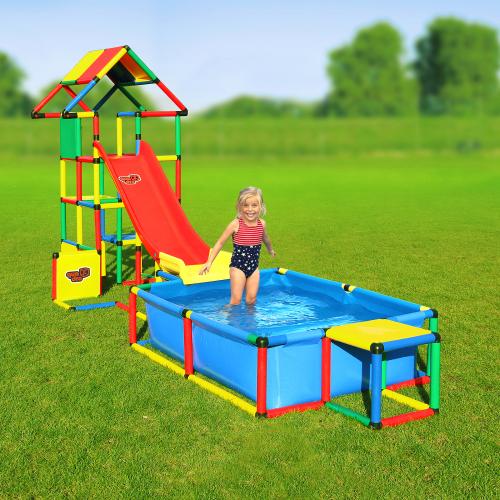
Safety First
In spite of all this fun, you need to remember to keep your little water babies safe. Infants and toddlers have to be supervised at all times, even in shallow water. Starting at an early age, you should teach your child that bodies of water are by no means harmless and the danger shouldn’t be underestimated. Position your pool at home so that the children in it are not exposed to direct sunlight. If that isn’t possible, you can make do with a sun umbrella or an awning. It’s best not to let the kids play in the pool at midday, and apply sunscreen liberally, preferably a sunscreen certified as all-natural with no nanoparticles. Set up the pool so that there’s no danger of slipping when the children run and roughhouse around it.
Want to Take Things to the Next Level?
What’s even better than a pool? A pool with a slide, of course! It’s no coincidence that when it comes to playground equipment, slides are one of the most popular. A combination of a slide and a pool is sure to put a smile on your children’s faces. At first it takes a little prodding and courage to let themselves go, but then they’re off, whee! Gravity takes effect; the rug rat picks up speed, has the feeling of being in free fall – but is safe on the slide. And then splash – they’re in the water, enjoying the cool down. What an amazing experience! And because it was so exciting, they go right back up again. And again. No lifeguard far and wide who could object. After all, you’re in your own backyard.

Children are fearless. They try new things and test their limits. And are often amazed to discover that they can suddenly do more than they were able to do a few days before, gaining confidence in themselves. The adrenaline rush from sliding fast gives them a high. They feel great – and also happy and agile due to the simultaneous release of endorphins. On hot days, they can really let loose without any risk. After all, slides made of plastic, which are mainly used in a residential setting, are tested for safety. They only absorb the ambient temperature to a limited extent and don’t get hot, as you may remember from your own childhood days at the playground, when a lot of slides were still made of metal.
When using a slide, as is often the case in life, first comes the “work,” then comes the fun. After all, kids first have to climb up the ladder or frame before enjoying the wild slide down. In addition, they develop their social skills when they have to wait at the bottom until another child has finished sliding. Only then is it their turn again.
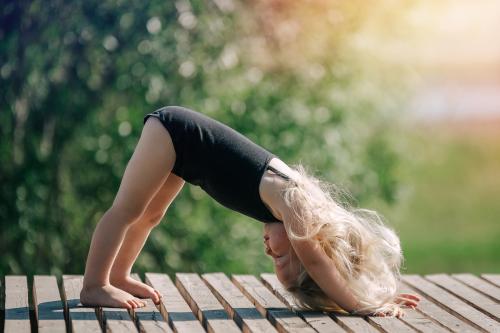
Outdoor exercise is extremely important, particularly in this age of smartphones, tablets, and TVs. Sliding is a kind of natural training. As the little adventurers climb up to get to the top, they pull themselves up with the help of their arms, and their legs also work as they climb, supplying their bodies with blood and oxygen to the cells. At the same time, they train their coordination and sense of balance, stimulating areas in the brain responsible for balance and the sense of touch. But it also trains proprioception, which is the perception of the position of the head, torso, and limbs in relation to each other and in space. The child gets a sense of its own strength, speed, and body tension. And along the way, they develop their sensory nervous system, which plays a critical role in more complex learning processes in later years.
Conclusion
Having your own pool with a slide is not only great fun for the little ones, it also lays an important foundation for their future lives. Children who come into contact with water at an early age lose their fear of the element, learn to swim, and generally develop well overall. A slide increases this effect even more. So, here’s to next summer in your own backyard!
And What Does All This Have to Do With QUADRO?
Here at QUADRO, we’re always thinking about what children might find interesting – and what’s important for them. We believe that a product should serve more than one purpose. That’s our mission. The results of our ongoing research are incorporated into the development of our products in order for you and your child to get the most out of them. Keep reading to learn how the findings from this article can be applied to our products.
QUADRO's PLUG-IN SYSTEM, patented in 1979, ensures that any QUADRO structure can be quickly assembled – and then later disassembled, if that’s what you want to do. This means you can rebuild the slide and pool inside in the fall. The materials are easy to clean, don’t absorb foreign odors, and don’t absorb water – so you don’t have to worry about your carpet. In the winter, you can effortlessly transform the pool into a ball cage with lots of colorful balls, creating a completely different kind of diving experience for the little ones.
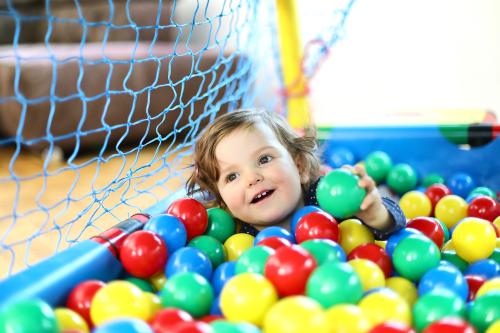
Choose the right pool for your rug rat – you can start with Pool S from about 12 months of age. This is where children gain their first experience in the water. Alternatively, you can fill the pool with sand to create a fun digging adventure. Pool L and Pool XXL can be combined with a slide. From here on out, the possibilities become virtually endless – would you like to build a castle together with your children? Or are they more in the mood for a swashbuckling pirate ship? Go for it! The pools can be combined with any construction kit, provided you have a QUADRO slide. And with the QUADRO software for your home PC, you can create designs that are every bit as good as those you would see at a water park. Don’t be surprised if your neighbors turn pale with envy. Let our extensive model database inspire you.
All our pools are completely safe and environmentally friendly. They don’t contain plasticizers or bisphenol A, short-chain chlorinated paraffins (SCCPs), or heavy metals (Pb, Cd). The pool liner is professional grade and can withstand quite a bit. All of our pools have a drain plug to allow the water to easily drain out. The tubes, connectors, screws, keys, and other elements made of polyethylene (HDPE) and polypropylene are also highly recyclable (recycling code 5 and 2).
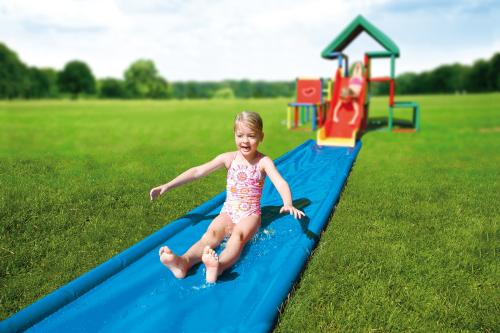
When it comes to slides, you also have a number of options – you can either go for the extremely stable integrated slide, which you simply hook onto a jungle gym or tower, or for the modular or curved slide, both of which can be combined to form a double slide. And if your kids still haven’t had enough, just add a Slip and Slide extension. You can just lay them on the lawn, right after the yellow runout.
For that real water park feeling, all of the slides come with a connector that you can attach a garden hose to. This is all it takes for the little ones to have their first taste of fun as they hold the opening shut every now and then, causing the water to spray uncontrollably and their playmates to get wet. In addition to causing them to scream with delight, they’re sure to enjoy the summer cool down.
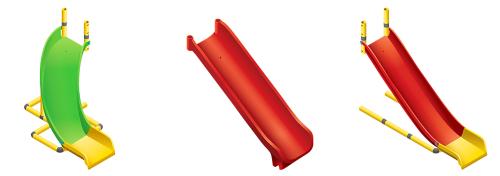
The integrated slide and the modular slide are both straight, but the length of the runout is different. The integrated slide is easy to set up; the modular slide requires a frame, which is, of course, included in the package. The curved slide is, as the name suggests, curved. Not only does the twist add a little thrill, but it’s extremely practical when used inside, as it takes up less space – in this case, your child more or less slides into the middle of the room. For added fun, the modular and curved slides can be combined to create a double slide. All three slides are compatible with the entire QUADRO product range – regardless of whether your product is brand new or perhaps dates back to 1979.
If you want to combine a QUADRO slide with a QUADRO pool, keep in mind that the integrated slide can be combined only with POOL XXL, while the curved and modular slides are compatible with both POOL L and POOL XXL. POOL S and XS cannot be combined with slides. One thing that all of our pools have in common is that they can be filled with water, sand, or balls.
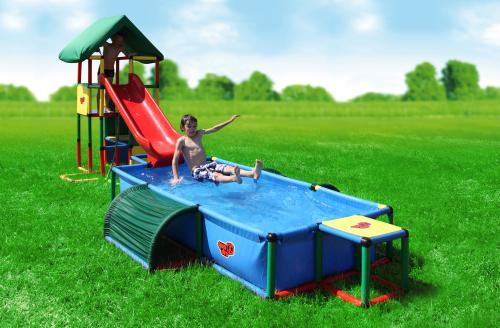
Your kids will be thrilled to receive – in addition to the modular or curved slide – a Slip and Slide extension. Every additional foot means a longer, and therefore more fun, sliding experience. And with an extension, they’ll get 20 of them at once! The high quality, fiber-reinforced tarp is designed to withstand many, many slides. In addition, it cushions uneven spots on the lawn better – after all, who likes sliding over rocks? The tarp stays where you set it up and doesn't move. Hooking it up to a water supply gives your kids the feeling of being at their favorite water park, all the way to the last few feet of the slide. And due to the barriers on the sides, the water flows down the length of the extension and can’t drain off sideways.
Read about the extravagant slide this imaginative family designed in the blog article Water Slide Deluxe.
Sources:
- Gábor Paál: Warum können Säuglinge tauchen, ohne sich zu verschlucken? SWR, 12. Februar 2021.
- Hermundur Sigmundsson, Brian Hopkins: Baby swimming: exploring the effects of early intervention on subsequent motor abilities. September 2009.
- Mindestens 378 Todesfälle durch Ertrinken. DLRG, 9. März 2021.
- Schwimmfähigkeit. DLRG, abgerufen am 18. Mai 2021.
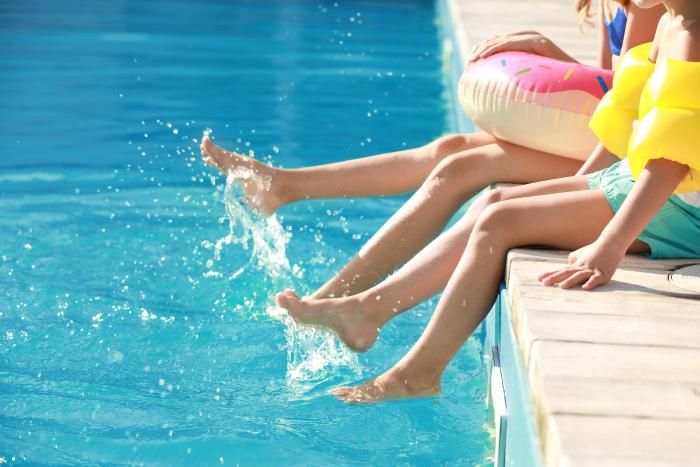
Comments